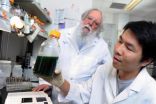(Press-News.org) Researchers have discovered in fruit flies a key metabolic hormone thought to be the exclusive property of vertebrates. The hormone, leptin, is a nutrient sensor, regulating energy intake and output and ultimately controlling appetite. As such, it is of keen interest to researchers investigating obesity and diabetes on the molecular level. But until now, complex mammals such as mice have been the only models for investigating the mechanisms of this critical hormone. These new findings suggest that fruit flies can provide significant insights into the molecular underpinnings of fat sensing.
"Leptin is very complex," said Akhila Rajan, first author on the paper and a postdoctoral researcher in the lab of Norbert Perrimon, James Stillman Professor of Developmental Biology at Harvard Medical School. "These types of hormones acquire more and more complex function as they evolve. Here in the fly we're seeing leptin in its most likely primitive form."
These findings will be published September 28 in Cell.
In order for an organism to function normally under varying conditions, its organ systems must learn to maintain a steady state, or "homeostasis." Coordinating food intake and nutrient stores with energy requirements is a key homeostatic mechanism referred to as energy homeostasis. Leptin regulates energy homeostasis by linking the organisms's fat stores with caloric intake. It is the hormone that tells the brain, "You've had enough."
Researchers have known for the better part of a decade that molecules secreted by the fruit fly's fat tissue communicate such nutrition status reports throughout the fly's entire body. However, they have not known the identity of these molecules, or the nature of the signals they transmit. Rajan hypothesized that this signaling molecule most likely resembles the leptin hormone in humans, since flies and mammals share similar nutrient-sensing pathways.
Researchers had predicted that three molecules in flies were likely to be structurally similar to leptin. When Rajan knocked out one of them, a protein called Upd2, the flies behaved, on a metabolic level, as though they were starving—despite consuming their normal caloric content.
"Since leptin is a nutrient sensor, this makes sense," said Rajan. "If you knock out the molecule that senses nutrients, the body thinks there are no nutrients. Blocking this molecule copied the phenotype of starvation."
Further tests showed that when flies were actually starving, levels of Upd2 went down, and when they received adequate nutrition, levels went up. This provided further evidence that, like leptin, Upd2 is a nutrient sensor.
Next, the researchers found that Upd2 uses a neural circuit similar to that of leptin to traffic nutrition information between the brain and fat tissue. When Upd2 reaches the brain, it regulates insulin secretion, in effect "telling" the fly to store nutrition and expend energy on growth.
Finally, Rajan and colleagues engineered a fly that lacked Upd2 altogether and inserted the human leptin gene in its place. The fly fully incorporated this mammalian molecule, and all normal nutrient-sensing functions resumed.
"The key significance here is that we can now take full advantage of the sophisticated genetic tool kit available in fly genetics to address profoundly complex questions pertaining to leptin biology," said Perrimon. "This is good news to scientists studying obesity at the molecular level."
Interestingly, the amino acid sequence of leptin diverges from that of Upd2. However, the proteins produced by each gene share many structural similarities. "There are very few examples of this in the literature," Perrimon said.
"Now that we've identified Upd2 as a fly's nutrient sensor and have begun to work out the brain circuitry, the next step is to go deep into the mechanisms," added Rajan.
###
This research was funded by the National Institutes of Health, grants 5P01CA120964 and 5R01DK088718.
Obesity-related hormone discovered in fruit flies
Findings open the field up to greater genetic exploration
2012-09-27
ELSE PRESS RELEASES FROM THIS DATE:
Aggressive cancer exploits MYC oncogene to amplify global gene activity
2012-09-27
CAMBRIDGE, Mass. (September 27, 2012) – For a cancer patient, over-expression of the MYC oncogene is a bad omen.
Scientists have long known that in tumor cells, elevated levels of MYC's protein product, c-Myc, are associated with poor clinical outcomes, including increased rates of metastasis, recurrence, and mortality. Yet decades of research producing thousands of scientific papers on the subject have failed to consistently explain precisely how c-Myc exerts its effects across a broad range of cancer types. Until now, that is.
The prevailing theory emerging from ...
Landmark guidelines for optimal quality care of geriatric surgical patients just released
2012-09-27
Chicago (September 27, 2012)—New comprehensive guidelines for the pre- operative care of the nation's elderly patients have been issued by the American College of Surgeons (ACS) and the American Geriatrics Society (AGS). The joint guidelines—published in the October issue of the Journal of the American College of Surgeons—apply to every patient who is 65 years and older as defined by Medicare regulations. The guidelines are the culmination of two years of research and analysis by a multidisciplinary expert panel representing the ACS and AGS, as well as by expert representatives ...
Uptick in cinematic smoking
2012-09-27
Top box office films last year showed more onscreen smoking than the prior year, reversing five years of steady progress in reducing tobacco imagery in movies, according to a new UCSF study.
Moreover, many of the top-grossing films of 2011 with significant amounts of smoking targeted a young audience, among them the PG-rated cartoon Rango and X-Men: First Class." The more smoking young people see in movies, the more likely they are to start smoking, the U.S. Surgeon General has reported.
The study will be available September 27, 2012 in Preventing Chronic Disease Journal, ...
Breakthrough in kitchen furniture production: Biocomposites challenge chipboard
2012-09-27
Biocomposites challenge chipboard as furniture material. Researchers at VTT Technical Research Centre of Finland have developed a kitchen furniture framework material from plastic polymers reinforced with natural fibre. The new material reduces raw materials consumption by 25 per cent and the carbon footprint of production by 35 per cent.
"The frames are lighter by nearly a third because they contain more air," says VTT's Research Professor Ali Harlin. "Wastage during production is also reduced. This is a generational shift that revolutionizes both manufacturing techniques ...
Breakthrough for new diabetes treatment
2012-09-27
In experiments on mice and rats, the scientists have managed to both prevent the development of type II diabetes and reverse the progression of established disease. The study is published in the prestigious scientific journal Nature, where it is described as a breakthrough in diabetes research. The findings are the result of a joint effort by Karolinska Institutet, the Ludwig Institute for Cancer Research and the Australian biopharmaceutical company CSL Limited, amongst others.
"It's a great feeling to present these results," says Professor Ulf Eriksson of the Department ...
ASU scientists bring the heat to refine renewable biofuel production
2012-09-27
TEMPE, Ariz.-Perhaps inspired by Arizona's blazing summers, Arizona State University scientists have developed a new method that relies on heat to improve the yield and lower the costs of high-energy biofuels production, making renewable energy production more of an everyday reality.
ASU has been at the forefront of algal research for renewable energy production. Since 2007, with support from federal, state and industry funding, ASU has spearheaded several projects that utilize photosynthetic microbes, called cyanobacteria, as a potential new source of renewable, carbon-neutral ...
La Bastida unearths 4,200-year-old fortification, unique in continental Europe
2012-09-27
Similar characteristics have not been observed in other constructions of the Bronze Age, with three-metre thick walls, square towers originally measuring up to seven metres, a monumental entrance and an ogival arched postern gate; a fully conserved architectural element unique in Europe in that period.
The wall protected a city measuring 4 hectares located on top of a hill. With architectural elements reminiscent of people with Eastern styled military skills, its model is typical of ancient civilisations of the Mediterranean, such as the second city of Troy.
The alignment ...
Scaling up polymer blobs
2012-09-27
Scientists use simulations to test the limits of their object of study—in this case thin films of polymers—to extremes of scale. In a study¹ about to be published in EPJ E, Nava Schulmann, a researcher at Strasbourg University, France, and colleagues use a well-known model capable of providing information on heat and mechanical energy exchange between these polymer chains. They found that polymer blends confined to ultrathin two-dimensional films displayed enhanced compatibility. This was made possible by simulations using a fairly standard model, which is simple enough ...
Nature's misfits: Reclassifying protists helps us understand how many species remain undiscovered
2012-09-27
Since the Victorian era, categorizing the natural world has challenged scientists. No group has presented a challenge as tricky as the protists, the tiny, complex life forms that are neither plants nor animals. A new reclassification of eukaryotic life forms, published in the Journal of Eukaryotic Microbiology, draws together the latest research to clarify the current state of protist diversity and categorization, as well as the many species that remain to be discovered.
"Protists include species traditionally referred to as protozoa and algae, some fungal-like organisms, ...
CNIO team discovers the first real indicator of longevity in mammals
2012-09-27
A team of researchers from the Spanish National Cancer Research Centre (CNIO), headed by CNIO Director María Blasco, has demonstrated in a pioneering study on mammals that longevity is defined at a molecular level by the length of telomeres. The work—which is published today in the online edition of the journal Cell Reports—opens the door to further study of these cellular components in order to calculate the rate at which cells age and thus be able to determine life expectancy for a particular organism.
Chromosomes—the cellular containers holding the genetic information ...
LAST 30 PRESS RELEASES:
iPS cells from dish to freezer and back
Deep neural networks enable accurate pricing of American options under stochastic volatility
Collective risk resonance in Chinese stock sectors uncovered through higher-order network analysis
Does CPU impact systemic risk contributions of Chinese sectors? Evidence from mixed frequency methods with asymmetric tail long memory
General intelligence framework to predict virus adaptation based on a genome language model
Antibiotic resistance is ancient, ecological, and deeply connected to human activity, new review shows
Vapes, pouches, heated tobacco, shisha, cigarettes: nicotine in all forms is toxic to the heart and blood vessels
From powder to planet: University of Modena engineers forge a low-carbon future for advanced metal manufacturing
Super strain-resistant superconductors
Pre-school health programme does not improve children’s diet or physical activity, prompting call for policy changes, study finds
Autumn clock change linked to reduction in certain health conditions
AI images of doctors can exaggerate and reinforce existing stereotypes
Where medicine meets melody – how lullabies help babies and parents in intensive care
We may never be able to tell if AI becomes conscious, argues philosopher
AI video translation shows promise but humans still hold the edge
Deep ocean earthquakes drive Southern Ocean’s massive phytoplankton blooms, study finds
Without campus leftovers to pick through, the beaks of this bird changed shape during the pandemic
High-dose antibiotic does not reduce mortality in tuberculous meningitis
How many insects fly in the sky above the USA?
Could cheese protect your brain health?
Who faces more difficulty recovering from stroke?
Colliding galaxies create the brightest, fastest growing black holes at their center
New BrainHealth research reveals tradeoffs on sleep with cannabis use for chronic pain
Aging-US now on ResearchGate, enhancing visibility for authors and readers
'Molecular glue' stabilizes protein that inhibits development of non-small cell lung cancer
Mount Sinai Health System is recognized in 2025 Chime Digital Health Most Wired survey
From prey to predator: How carnivores spread beneficial fungi
Menopause symptoms may be frequent and have negative effects, according to female endurance athletes
US Congressmembers’ responses on X to mass shooting events differ along party lines
KAIST-UEL team develops “origami” airless wheel to explore lunar caves
[Press-News.org] Obesity-related hormone discovered in fruit fliesFindings open the field up to greater genetic exploration

